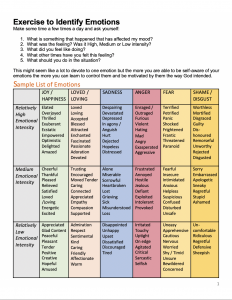In the document Increasing Resilience in Adversity, a component of resilience was identified as “Working on emotional self-awareness and regulation. Of those pastoral workers surveyed, many indicated that they believed they needed to work on this.
Bible-believing followers of Jesus understand that as human beings made in the image of God, we are complex unities; as Jesus indicated when he answered one of the teachers of the law:
“Love the Lord your God with all your heart and with all your soul and with all your mind and with all your strength.” Mark 12:30
Part of that wonderful complexity are our emotions. We were made to be emotional beings as God’s image bearers. Unfortunately, in the Fall, sin had its impact as much on our emotions as it did on our body: emotions out of control or in the driver’s seat, emotions (‘love’ for instance) assuming a place and a role that belongs to God who is Love and emotions denied. Part of what salvation means is the right ordering and use of our emotions. But we can’t engage in that humanising activity unless we are aware of our emotions and that requires self-awareness. Being unaware of our emotions doesn’t mean we don’t have them, it just means that we are unlikely to keep them under control and we will use our mind to justify why our ‘anger, fear or love’ was the right thing to do.
Presbyterians like thinking, but sometimes we can think too much. One time when Kath and I were in counselling, the counsellor was focussing on Kath, which was fine with me, but then she turned to me and asked, ‘David, how does that make you feel?’ I started off with ‘I think that…’. She stopped me and asked again, ‘How does what Kathy said make you feel?’ Deep breath, ‘I think…’ She stopped me again, ‘I’m not asking what you think but what you feel, OK?’ Internally, ‘Come on mate you are looking like a wombat here.’ I kid you not, for a fourth time I started the sentence with ‘I think…”. Then I said something very true and worth saying, ‘I don’t know what I feel.’
At that point I realised I needed to do some work on my feelings; identifying them, working out why I had them, what they wanted me to do and what I should chose to do. Our counsellor talked about how God made our bodies as a way of indicating what we were feeling.
What follows is a table of the main emotions broken up into High, Medium and Low intensity. Below that is a map of our body undergoing different emotions. It also includes an exercise I used back then and continue to use.
Dave Thurston (Introduction & Exercise)
Tim Dyer (Diagrams)


